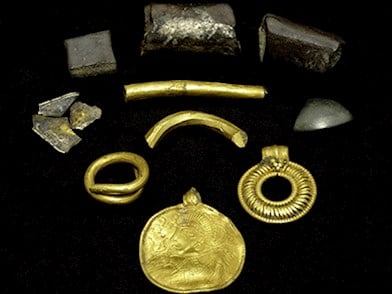A local treasure hunter named Carsten Helm, along with his 10 and 12-year-old sons, discovered a trove of gold on the island of Lolland that dates back 1,500 years.
Among the gold discovered was a so-called bracteate, a thin gold medallion worn as jewellery during the Germanic Iron Age. Archaeologists at Museum Lolland-Falster believe that the image on the amulet depicts Nordic god Odin. Their conclusion was based on other finds of similar bracteates that include a rune inscription reading ‘The High One’, one of Odin’s nicknames.
“It is a very exciting find,” museum spokeswoman Marie Brinch said. “Even though it is a previously-known type, it is a rare and exciting discovery. Throughout history there have only been three found on Lolland, the latest in 1906, and in all of Northern Europe there are only around 1,000 of them.”
Helm and his sons also found an additional gold pendant, three gold pieces that were likely parts of a necklace, a gold ring and assorted pieces of silver.
Their finds will go on display at the Maribo County Museum on Friday.
The Odin amulet is merely the latest in a long line of significant archaeological finds made in Denmark this year. Just earlier this week, a team of archaeologists digging in a field east of Ribe found what appeared to be part of a Viking gold bracelet on the same site that in June produced the largest ever discovery of Viking gold in Denmark.
Other notable 2016 discoveries have included an 1,100-year-old crucifix that may change the understanding of when Christianity came to Denmark, an amulet depicting Odin's ravens, a hoard of 700 year-old coins, and a ‘lost' rune stone that turned up in a farmer's backyard, to name just a few. And in summer 2015, 2,000 gold spirals used by sun-worshiping priest-kings during the Bronze Age were found in a field in Zealand.
All of the recent finds have created such a backlog at the National Museum of Denmark that the museum simply cannot process them in a timely manner.


 Please whitelist us to continue reading.
Please whitelist us to continue reading.
Member comments